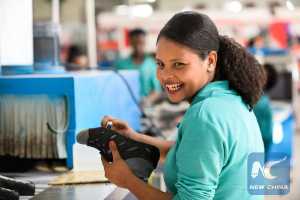- Stay Connected
Ethiopia taps Chinese firms to employ a burgeoning youth population

Addis Ababa, April 24, 2017 (FBC) – Selam Fantahun, an Ethiopian high school dropout, feels that her life’s prospects have brightened up since she landed a job at a Chinese shoe factory in Addis Ababa four months ago.
“I wouldn’t say I’ve learned 100 percent of what I aspired to but I’m getting there, learning new skills every day,” says the perky girl.
Selam attaches soles of slipper shoes at the new partially finished plant of Huajian, a major Chinese shoe manufacturer. Encouraged by the salary increases and skills training of the company, she plans to stay a bit longer before planning to start her own business.
Selam is among the latest crop of Ethiopians learning skills in Huajian’s second plant located on southern outskirt of the capital. Huajian has already established a shoe factory for six years in Dukem Industrial Zone 37 kms southeast of Addis Ababa.
The spacious plant named Huajian International Light Industry City covers 138 hectares, and is expected to be totally completed by 2020.
The new park expects to earn two billion U.S. dollars in annual export revenue and employ up to 50,000 Ethiopians.
That may seem ambitious, but perfectly attainable in the eyes of Zemdeneh Negatu, former managing partner of the consulting firm Ernest and Young (Ethiopia).
“Ethiopia has 100 million people, adds 2.5 million people annually. It has a young, dynamic, educated and affordable labor force only matched in Africa by Nigeria,” says Zemdeneh.
He also cites Ethiopia’s cheap electricity rates at four U.S. dollar cents per kilowatt hour and the country’s 4,200 megawatts of installed electricity capacity, second only to South Africa.
Arkebe Oqubay, board chairperson of Industrial Park Development Corporation, sees the benefit of firms like Huajian not just in terms of export revenues and employment opportunities.
“With china rebalancing its economy, its firms are eyeing Ethiopia’s young labor force of 45 million, while also being attracted by the relative affordability of wage in Ethiopia,” he says.
According to him, with the annual manufacturing growth standing at 25 percent in the coming 10 years the government hopes the share of manufacturing in exports will increase to 50 percent.
“In 10 years time, Ethiopia will be among the top ten populous nations in the world, with manufacturing creating two indirect jobs for every one direct jobs,” says Oqubay, highlighting another rationale for the country’s strong focus on manufacturing.
Already the country has inaugurated three industrial parks. The Hawassa Industrial Park (HIP) with a capacity to employ 60,000 people was built in a record nine months by China Civil Engineering Construction Corporation (CCECC).
Oqubay says nine more industrial park projects are planned or currently under construction by the Ethiopian government with an ability to employ more than 200,000 people when finished.
The industrialization plan is also part of the government’s grand strategy to achieve middle income status for the nation by 2025.
With Ethiopian economy still dominated by agricultural commodities subjected to international price volatility and an ever increasing urban population standing at around 18 percent, the government counts on these projects to help create enough jobs and improve people’s livelihoods.
